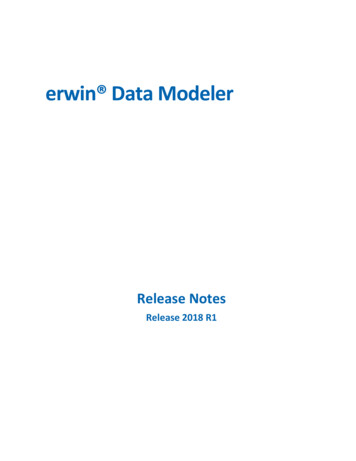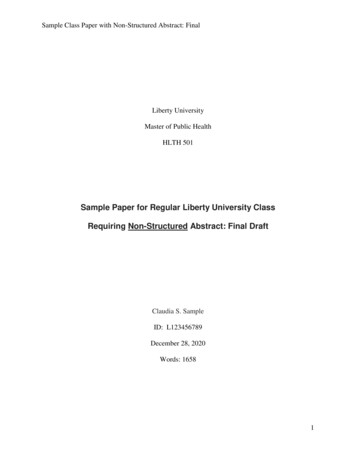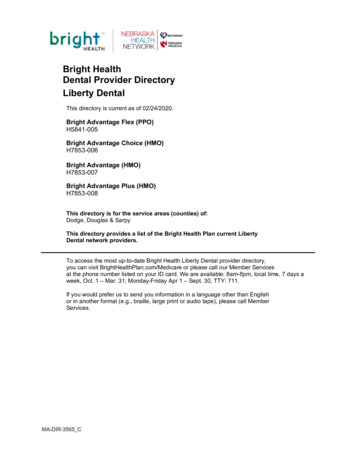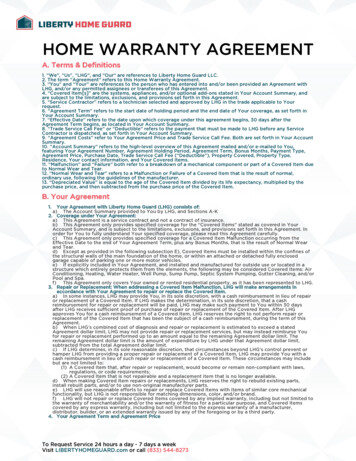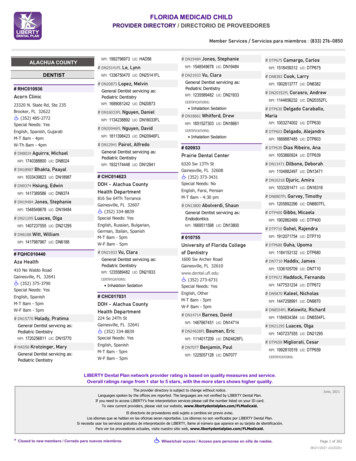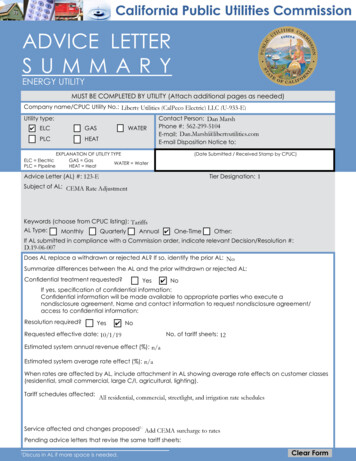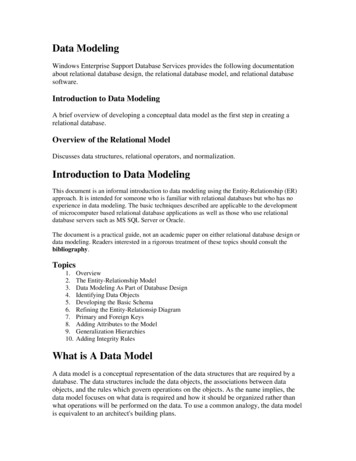
Transcription
Data ModelingWindows Enterprise Support Database Services provides the following documentationabout relational database design, the relational database model, and relational databasesoftware.Introduction to Data ModelingA brief overview of developing a conceptual data model as the first step in creating arelational database.Overview of the Relational ModelDiscusses data structures, relational operators, and normalization.Introduction to Data ModelingThis document is an informal introduction to data modeling using the Entity-Relationship (ER)approach. It is intended for someone who is familiar with relational databases but who has noexperience in data modeling. The basic techniques described are applicable to the developmentof microcomputer based relational database applications as well as those who use relationaldatabase servers such as MS SQL Server or Oracle.The document is a practical guide, not an academic paper on either relational database design ordata modeling. Readers interested in a rigorous treatment of these topics should consult wThe Entity-Relationship ModelData Modeling As Part of Database DesignIdentifying Data ObjectsDeveloping the Basic SchemaRefining the Entity-Relationsip DiagramPrimary and Foreign KeysAdding Attributes to the ModelGeneralization HierarchiesAdding Integrity RulesWhat is A Data ModelA data model is a conceptual representation of the data structures that are required by adatabase. The data structures include the data objects, the associations between dataobjects, and the rules which govern operations on the objects. As the name implies, thedata model focuses on what data is required and how it should be organized rather thanwhat operations will be performed on the data. To use a common analogy, the data modelis equivalent to an architect's building plans.
A data model is independent of hardware or software constraints. Rather than try torepresent the data as a database would see it, the data model focuses on representing thedata as the user sees it in the "real world". It serves as a bridge between the concepts thatmake up real-world events and processes and the physical representation of thoseconcepts in a database.MethodologyThere are two major methodologies used to create a data model: the Entity-Relationship(ER) approach and the Object Model. This document uses the Entity-Relationshipapproach.Data Modeling In the Context of Database DesignDatabase design is defined as: "design the logical and physical structure of one or moredatabases to accommodate the information needs of the users in an organization for adefined set of applications". The design process roughly follows five steps:1.2.3.4.5.planning and analysisconceptual designlogical designphysical designimplementationThe data model is one part of the conceptual design process. The other, typically is thefunctional model. The data model focuses on what data should be stored in the databasewhile the functional model deals with how the data is processed. To put this in thecontext of the relational database, the data model is used to design the relational tables.The functional model is used to design the queries which will access and performoperations on those tables.Components of A Data ModelThe data model gets its inputs from the planning and analysis stage. Here the modeler,along with analysts, collects information about the requirements of the database byreviewing existing documentation and interviewing end-users.The data model has two outputs. The first is an entity-relationship diagram whichrepresents the data strucures in a pictorial form. Because the diagram is easily learned, itis valuable tool to communicate the model to the end-user. The second component is adata document. This a document that describes in detail the data objects, relationships,and rules required by the database. The dictionary provides the detail required by thedatabase developer to construct the physical database.
Why is Data Modeling Important?Data modeling is probably the most labor intensive and time consuming part of thedevelopment process. Why bother especially if you are pressed for time? A commonresponse by practitioners who write on the subject is that you should no more build adatabase without a model than you should build a house without blueprints.The goal of the data model is to make sure that the all data objects required by thedatabase are completely and accurately represented. Because the data model uses easilyunderstood notations and natural language , it can be reviewed and verified as correct bythe end-users.The data model is also detailed enough to be used by the database developers to use as a"blueprint" for building the physical database. The information contained in the datamodel will be used to define the relational tables, primary and foreign keys, storedprocedures, and triggers. A poorly designed database will require more time in the longterm. Without careful planning you may create a database that omits data required tocreate critical reports, produces results that are incorrect or inconsistent, and is unable toaccommodate changes in the user's requirements.SummaryA data model is a plan for building a database. To be effective, it must be simple enoughto communicate to the end user the data structure required by the database yet detailedenough for the database design to use to create the physical structure.The Entity-Relation Model (ER) is the most common method used to build data modelsfor relational databases. The next section provides a brief introduction to the conceptsused by the ER Model.The Entity-Relationship ModelThe Entity-Relationship (ER) model was originally proposed by Peter in 1976 [Chen76]as a way to unify the network and relational database views. Simply stated the ER modelis a conceptual data model that views the real world as entities and relationships. A basiccomponent of the model is the Entity-Relationship diagram which is used to visuallyrepresents data objects. Since Chen wrote his paper the model has been extended andtoday it is commonly used for database design For the database designer, the utility of theER model is:* it maps well to the relational model. The constructs used in the ER model caneasily be transformed into relational tables.* it is simple and easy to understand with a minimum of training. Therefore, themodel can be used by the database designer to communicate the design to the enduser.
* In addition, the model can be used as a design plan by the database developer toimplement a data model in a specific database management software.Basic Constructs of E-R ModelingThe ER model views the real world as a construct of entities and association betweenentities.EntitiesEntities are the principal data object about which information is to be collected. Entitiesare usually recognizable concepts, either concrete or abstract, such as person, places,things, or events which have relevance to the database. Some specific examples ofentities are EMPLOYEES, PROJECTS, INVOICES. An entity is analogous to a table inthe relational model.Entities are classified as independent or dependent (in some methodologies, the termsused are strong and weak, respectively). An independent entity is one that does not relyon another for identification. A dependent entity is one that relies on another foridentification.An entity occurrence (also called an instance) is an individual occurrence of an entity. Anoccurrence is analogous to a row in the relational table.Special Entity TypesAssociative entities (also known as intersection entities) are entities used to associate twoor more entities in order to reconcile a many-to-many relationship.Subtypes entities are used in generalization hierarchies to represent a subset of instancesof their parent entity, called the supertype, but which have attributes or relationships thatapply only to the subset.Associative entities and generalization hierarchies are discussed in more detail below.
RelationshipsA Relationship represents an association between two or more entities. An example of arelationship would be:employees are assigned to projectsprojects have subtasksdepartments manage one or more projectsRelationships are classified in terms of degree, connectivity, cardinality, and existence.These concepts will be discussed below.AttributesAttributes describe the entity of which they are associated. A particular instance of anattribute is a value. For example, "Jane R. Hathaway" is one value of the attribute Name.The domainof an attribute is the collection of all possible values an attribute can have.The domain of Name is a character string.Attributes can be classified as identifiers or descriptors. Identifiers, more commonlycalled keys, uniquely identify an instance of an entity. A descriptor describes a nonunique characteristic of an entity instance.Classifying RelationshipsRelationships are classified by their degree, connectivity, cardinality, direction, type, andexistence. Not all modeling methodologies use all these classifications.Degree of a RelationshipThe degree of a relationship is the number of entities associated with the relationship. Then-ary relationship is the general form for degree n. Special cases are the binary, andternary ,where the degree is 2, and 3, respectively.Binary relationships, the association between two entities is the most common type in thereal world. A recursive binary relationship occurs when an entity is related to itself. Anexample might be "some employees are married to other employees".A ternary relationship involves three entities and is used when a binary relationship isinadequate. Many modeling approaches recognize only binary relationships. Ternary or nary relationships are decomposed into two or more binary relationships.
Connectivity and CardinalityThe connectivity of a relationship describes the mapping of associated entity instances inthe relationship. The values of connectivity are "one" or "many". The cardinality of arelationship is the actual number of related occurences for each of the two entities. Thebasic types of connectivity for relations are: one-to-one, one-to-many, and many-to-many.A one-to-one (1:1) relationship is when at most one instance of a entity A is associatedwith one instance of entity B. For example, "employees in the company are each assignedtheir own office. For each employee there exists a unique office and for each office thereexists a unique employee.A one-to-many (1:N) relationships is when for one instance of entity A, there are zero,one, or many instances of entity B, but for one instance of entity B, there is only oneinstance of entity A. An example of a 1:N relationships isa department has many employeeseach employee is assigned to one departmentA many-to-many (M:N) relationship, sometimes called non-specific, is when for oneinstance of entity A, there are zero, one, or many instances of entity B and for oneinstance of entity B there are zero, one, or many instances of entity A. An example is:employees can be assigned to no more than two projects at the same time;projects must have assigned at least three employeesA single employee can be assigned to many projects; conversely, a single project canhave assigned to it many employee. Here the cardinality for the relationship betweenemployees and projects is two and the cardinality between project and employee is three.Many-to-many relationships cannot be directly translated to relational tables but insteadmust be transformed into two or more one-to-many relationships using associativeentities.DirectionThe direction of a relationship indicates the originating entity of a binary relationship.The entity from which a relationship originates is the parent entity; the entity where therelationship terminates is the child entity.The direction of a relationship is determined by its connectivity. In a one-to-onerelationship the direction is from the independent entity to a dependent entity. If bothentities are independent, the direction is arbitrary. With one-to-many relationships, theentity occurring once is the parent. The direction of many-to-many relationships isarbitrary.
TypeAn identifying relationship is one in which one of the child entities is also a dependententity. A non-identifying relationship is one in which both entities are independent.ExistenceExistence denotes whether the existence of an entity instance is dependent upon theexistence of another, related, entity instance. The existence of an entity in a relationship isdefined as either mandatory or optional. If an instance of an entity must always occur foran entity to be included in a relationship, then it is mandatory. An example of mandatoryexistence is the statement "every project must be managed by a single department". If theinstance of the entity is not required, it is optional. An example of optional existence isthe statement, "employees may be assigned to work on projects".Generalization HierarchiesA generalization hierarchy is a form of abstraction that specifies that two or more entitiesthat share common attributes can be generalized into a higher level entity type called asupertype or generic entity. The lower-level of entities become the subtype, or categories,to the supertype. Subtypes are dependent entities.Generalization occurs when two or more entities represent categories of the same realworld object. For example, Wages Employees and Classified Employees representcategories of the same entity, Employees. In this example, Employees would be thesupertype; Wages Employees and Classified Employees would be the subtypes.Subtypes can be either mutually exclusive (disjoint) or overlapping (inclusive). Amutually exclusive category is when an entity instance can be in only one category. Theabove example is a mutually exclusive category. An employee can either be wages orclassified but not both. An overlapping category is wh
data model focuses on what data is required and how it should be organized rather than what operations will be performed on the data. To use a common analogy, the data model is equivalent to an .
